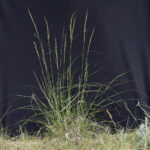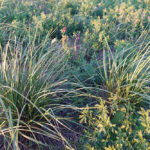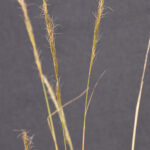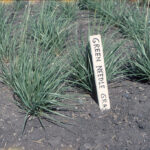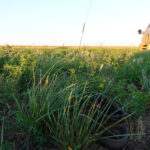Herbe aiguille verte
Nassella viridula
General Description
Green needlegrass is a native perennial bunchgrass with available cultivars. Narrow leaves average 10-30 cm (4-12 in) long with prominent veins and a rough surface. Green needlegrass has deep fibrous roots to support its good yield which comes from lots of leaves all growing from the base (basal growth). The seeds are small and hairy with a short soft bent awn. Green needlegrass is nutritious and palatable throughout the growing season and winter.
Type
Native grass.
Origin
Mixed Grass Prairie of North America. Cultivars/varieties have been developed.
Longevity
Long-lived.
Use
Pasture, reclamation, stockpiling.
Optimal Time of Use
Summer, fall, winter. Green needlegrass should be grazed between early summer and fall or can be stockpiled for fall or winter grazing.
Recovery After Use
For maximum persistence graze green needlegrass once per season. Recovery can occur within 60-80 days in cultivars.
Palatability/Nutritional Value
Green needlegrass has an average digestibility ranging from 52% in May to 45% in September and crude protein levels ranging from 20% (spring) to 7 % (fall). Green needlegrass is very palatable and can decline in mixed stands due to selective grazing by livestock. Green needlegrass awns are not problematic to grazing livestock.
Annual Precipitation min/max (mm)
305mm to 610mm.
Drought Tolerance
Moderate to high tolerance.
Flooding Tolerance
Green needlegrass withstands saturated soils for approximately one week in the spring.
Winter Hardiness
Good hardiness.
Soil Texture Preference
It is suited to loamy to clay-loam soils in well drained but moist areas. It is naturally found on north facing slopes, in slight depressions, and between hills.
Erosion Control
Once established, green needlegrass has good soil holding characteristics and adds high levels of organic matter to the soil.
Salinity Tolerance
Low tolerance.
Acidity Tolerance
No tolerance. Tolerates soil pH above 6.6.
Alkalinity Tolerance
Low to moderate tolerance.
Seeds per kg
399,000 seeds/kg (181,000 seeds/lb).
Suggested Mixtures
Producers have successfully grown green needlegrass with meadow bromegrass, western wheatgrass and legumes in mixed stands and other native species for reclamation.
Ease of Establishment
Green needlegrass seeds require a period of cold or vernalization prior to germination. New cultivars germinate more readily than earlier cultivars. Once seedlings emerge they are vigorous. Cultivars easily spread from seed within a field.
Competitiveness
Green needlegrass cultivars have proven competitive in mixed stands once established. Practice good weed control before seeding.
Management Considerations
To maintain productivity, provide adequate rest following defoliation and include a legume in the stand or fertilize with nitrogen fertilizer.
Saskatchewan Dryland Forage Species Adaptation Tool, AAFC Field Guide to Selected Native Forages, USDA Plants Database
Green needlegrass occurs on warmer grassland sites along the Peace River and its tributaries.
